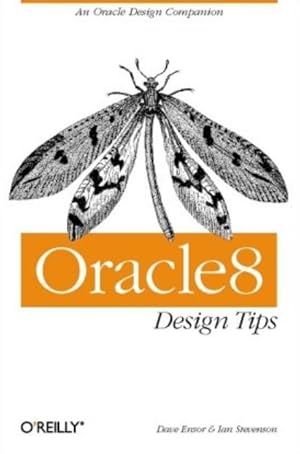oracle design tips de ensor dave (1 resultados)
ComentariosFiltros de búsqueda
Tipo de artículo
- Todos los tipos de productos
- Libros (1)
- Revistas y publicaciones (No hay ningún otro resultado que coincida con este filtro.)
- Cómics (No hay ningún otro resultado que coincida con este filtro.)
- Partituras (No hay ningún otro resultado que coincida con este filtro.)
- Arte, grabados y pósters (No hay ningún otro resultado que coincida con este filtro.)
- Fotografías (No hay ningún otro resultado que coincida con este filtro.)
- Mapas (No hay ningún otro resultado que coincida con este filtro.)
- Manuscritos y coleccionismo de papel (No hay ningún otro resultado que coincida con este filtro.)
Condición
- Todos los libros
- Nuevos (1)
- Antiguos o usados (No hay ningún otro resultado que coincida con este filtro.)
Encuadernación
- Todas
- Tapa dura (No hay ningún otro resultado que coincida con este filtro.)
- Tapa blanda (1)
Más atributos
- Primera edición (No hay ningún otro resultado que coincida con este filtro.)
- Firmado (No hay ningún otro resultado que coincida con este filtro.)
- Sobrecubierta (1)
- Con imágenes (1)
- No impresión bajo demanda (1)
Idioma (1)
Precio
- Cualquier precio
- Menos de EUR 20
- EUR 20 a EUR 40 (No hay ningún otro resultado que coincida con este filtro.)
- Más de EUR 40 (No hay ningún otro resultado que coincida con este filtro.)
Gastos de envío gratis
- Envío gratis a España (No hay ningún otro resultado que coincida con este filtro.)
Ubicación del vendedor
Valoración de los vendedores
-
EUR 15,80
Convertir monedaEUR 31,42 gastos de envío desde Chile a EspañaCantidad disponible: 1 disponibles
Añadir al carritoBlanda. Condición: New. Estado de la sobrecubierta: Nuevo. No Aplica Ilustrador. 1. The latest version of the Oracle relational database management system, Oracle8, was released in the summer of 1997. The new version offers some dramatically different features from previous versions, including better scalability, reliability, and security; an object-relational model; additional datatypes; and much more. To get peak performance out of an Oracle8 system, databases and code need to be designed with these new features in mind. This small book tells Oracle designers and developers just what they need to know to use the Oracle8 features to best advantage.O'Reilly's Oracle Design, released in April 1997, has been very well received by the Oracle community. The design of both databases and applications is an often-neglected area of Oracle, but one that has an enormous impact on the ultimate power and performance of a system. If the initial design is poor, then the most powerful hardware, the most sophisticated software tools, and the most highly tuned data and programs won't make a system run smoothly and efficiently. Oracle Design focuses on both database and code design, including such special design areas as data models, denormalization, the use of keys and indexes, temporal data, special architectures (client/server, distributed database, parallel processing), and data warehouses. Written primarily for Oracle7 (through 7.3), it also takes a look ahead at some of the features announced for Oracle8.Oracle8 Design Tips is a companion volume for Oracle Design. Written by Dave Ensor and Ian Stevenson, authors of the original volume, the mini-book focuses on the new features of Oracle8 and on the object-relational model of the new version. Virtually all of the advice in the original book is still absolutely on target (regardless of what version of Oracle you are running). But the mini-book updates that advice to tell you how to capitalize on the latest features. Used together, the two volumes provide immensely valuable and up-to-the-minute information for anyone trying to design for the latest version of the Oracle RDBMS.Chapters include:1. What's New in Oracle8? An overview of Oracle8 and Oracle's approach.2. Methodologies for Oracle8. Can traditional methodologies be used for development in an object-oriented environment? What approaches are best for Oracle's new object-relational model?3. Miscellaneous Oracle8 Enhancements. Discussions of a variety of new features, including triggers and backups.4. Oracle8's "Big" Features. Design hints for using features that support very large databases, including large objects (LOBs), partitioned objects, indexes and tables, cooperative indexing, etc.5. Objects. A general discussion of the object-oriented technology that underlies Oracle8--for example, how do such features as encapsulation, inheritance, and polymorphism apply in an Oracle environment?6. Tools Support for Oracle8. The use of tools like Sedona, Developer/2000, Designer/2000, Object Designer, SQL*Plus, C/C++, and Java with Oracle8. 210 gr. Libro.


